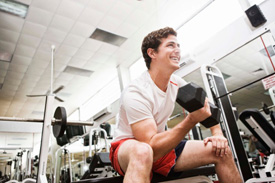Your back will thank you
 A couple of weeks ago, one of our patients strained a back muscle just trying to get into position to do an exercise at the gym – the front squat. A week later, he tried it again, with the same weight. This time, he did three sets of six repetitions – 18 reps in all – with no problem.
A couple of weeks ago, one of our patients strained a back muscle just trying to get into position to do an exercise at the gym – the front squat. A week later, he tried it again, with the same weight. This time, he did three sets of six repetitions – 18 reps in all – with no problem.
The human body is a wondrous thing. It can be horrifyingly fragile, but at the same time, incredibly strong and resilient.
It all comes down to proper maintenance and technique.
How you lift is important
Technique is important in everything you do, regardless of whether you ever step foot into a gym and pick up a weight. For example, take a look at how you’re supposed to do the front squat. All those key points listed in this video ensure you’re working the muscles you’re supposed to, as safely as possible to avoid injury.
It will likely come as little surprise that many of our patients with back injuries didn’t suffer them in a gym, but instead from doing those little mundane things – bending down to pick up the paper, or pulling a weed in the garden, or hoisting up a toddler. There’s a reason why we’re always told to “lift with our knees” because that shields the muscles of your lower back from excessive strain.
Lifting a heavy object from a bent over position, twisting sideways, or any sudden movement that engages those back muscles can cause muscles or ligaments to stretch far enough for microscopic tears to occur. The only cure is rest. And as we’ve touched on many times before, poor posture and repetitive stress can also leave you with more serious back problems.
The simple fix is to be careful when lifting, bending, or reaching. Wherever possible, bend with the knees, keep your shoulders back, and your lower back curved in. You don’t want your back to round out. Consider your posture when you slump in a chair versus when you practice proper ergonomics and sit erect with heels flat on the floor and shoulders back – the same idea applies when reaching or lifting.
But cold muscles need to warm up, too
The other key is maintenance – if you plan to engage in an activity likely to strain the back, prepare for it.
In the case of our patient in the gym, the big difference between his two visits was how he warmed up. The front squat is a movement that demands a lot of stability in the core – engaged abdominal muscles are key to maintaining the right posture and protecting the lower back from excessive strain. His second time in the gym, he took more time to better warm up and activate his core with a number of light exercises before heading for the squat rack. Warming up by doing the front squat with a lighter weight by itself wasn’t enough.
So anytime you plan to work in the garden or the yard, or head to the gym, take time to activate your core and warm up your back. Active exercises are best. Static exercises where you just hold the stretch for a time are better for after you’ve completed your activity because, again, straining cold muscles that way can lead to injury.
If you have any questions give us a call today!
